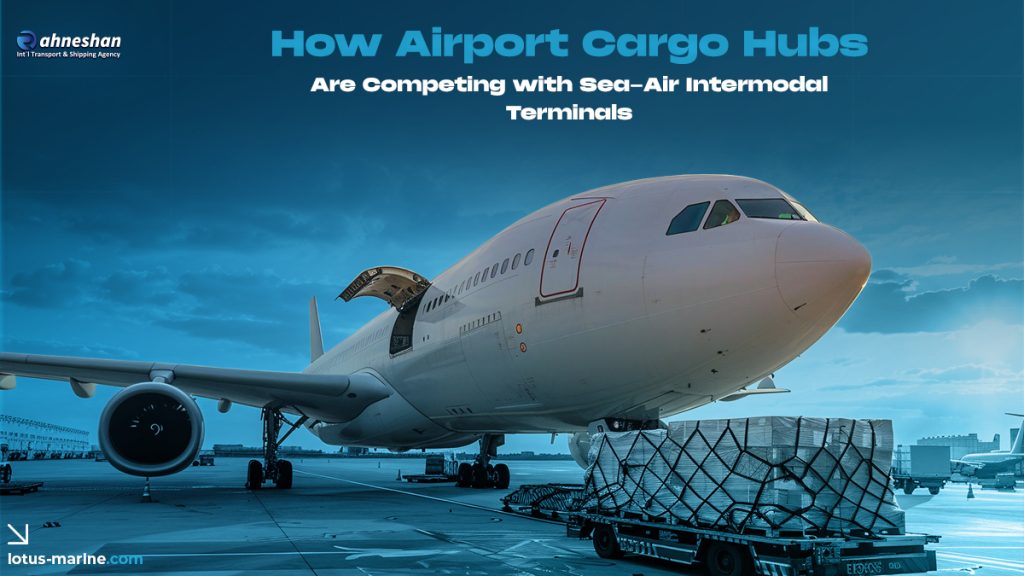Introduction
As global trade networks evolve, the boundaries between sea and air logistics are blurring. The rise of intermodal freight solutions—especially sea–air transport—has created new competition for traditional airport cargo hubs. These hybrid terminals combine the cost efficiency of ocean freight with the speed of air transport, challenging airports to innovate and redefine their value in the logistics chain. In 2025, the competition between airport cargo hubs and sea–air terminals has become a key factor shaping global supply chain strategies.
The Rise of Sea–Air Intermodal Terminals
Sea–air logistics allows cargo to be shipped by sea for the long-haul segment and then transferred to air for faster final delivery—or vice versa.
This hybrid model is gaining traction in regions like:
-
Dubai & Singapore – acting as global sea–air gateways between Asia, Europe, and Africa.
-
Incheon, Busan, and Kuala Lumpur – connecting East Asian exports with Western markets.
The result? Transit times cut by 30–40% compared to all-sea routes, and costs up to 50% lower than all-air shipments.
Why Airport Cargo Hubs Feel the Pressure
1. Price Sensitivity
Sea–air terminals offer competitive pricing that appeals to shippers balancing speed and cost—especially in industries like electronics, fashion, and pharmaceuticals.
2. Integrated Infrastructure
Modern sea–air hubs feature customs-free zones, automated container handling, and shared data platforms, reducing dwell times and transfer delays.
3. Sustainability Goals
Hybrid logistics models reduce carbon emissions per ton-kilometer, aligning with corporate ESG targets and IMO/ICAO climate mandates.
How Airport Cargo Hubs Are Responding
1. Digitization and Smart Infrastructure
Airports are investing in AI-driven cargo management systems, IoT sensors, and real-time visibility platforms to enhance throughput and reliability.
Examples include:
-
Changi Airport (Singapore): Using digital twins for predictive cargo flow management.
-
Heathrow & Frankfurt: Automating ULD (Unit Load Device) tracking with RFID.
2. Expanding Multimodal Connectivity
Airports are increasingly connecting directly to rail and maritime terminals, creating air–sea–land logistics corridors. For example, Amsterdam Schiphol integrates air cargo with Rotterdam Port, offering synchronized operations and shared customs systems.
3. Cold Chain Specialization
To counter hybrid competition, many airport hubs are focusing on temperature-controlled cargo—pharma, biotech, and perishables—where speed and certification are paramount.
4. Green Energy and Carbon-Neutral Operations
Airports are committing to carbon-neutral cargo zones powered by renewable energy and electrified ground handling fleets, reinforcing their sustainability edge.
Technological Enablers
-
AI & Predictive Analytics: For demand forecasting and cargo routing optimization.
-
Blockchain: Ensures transparency across multimodal transfers and customs documentation.
-
5G Connectivity: Enables real-time tracking of cargo pallets, vehicles, and sensors.
-
Automation: Robotics for ULD handling and autonomous tugs improve turnaround efficiency.
Advantages of Airport Cargo Hubs
| Factor | Airport Cargo Hubs | Sea–Air Terminals |
|---|---|---|
| Speed | Fastest mode (air-only) | Moderate (sea + air) |
| Cost | Higher | 30–50% cheaper |
| Reliability | High schedule predictability | Dependent on port/airline synchronization |
| Environmental Impact | Higher emissions | Lower carbon footprint |
| Customs Integration | Strong (direct clearance) | Often bonded zones with shared processes |
| Ideal Cargo Types | Pharma, e-commerce, urgent freight | Bulk electronics, apparel, general goods |
Emerging Trends in 2025
-
Regionalization of Supply Chains: Airports near manufacturing hubs are becoming micro-logistics centers for time-critical cargo.
-
AI-Based Mode Selection: Logistics software dynamically assigns shipments to air, sea–air, or ground based on real-time data.
-
Collaborative Models: Some airports now partner with ports to create shared intermodal ecosystems, rather than compete directly.
Future Outlook
By 2030, the competition will shift toward collaboration. Instead of choosing between air and sea–air logistics, major gateways will function as integrated freight ecosystems, combining the speed of air with the efficiency of sea transport through unified digital networks.
Airport hubs that embrace multimodal digital transformation will not only stay relevant—but lead the next era of global logistics efficiency.
Conclusion
Airport cargo hubs are no longer competing solely on speed—they’re competing on data, connectivity, and sustainability. As sea–air intermodal terminals reshape global logistics, the future belongs to airports that can evolve into smart, multimodal freight ecosystems. The winners of 2025 will be those who blend digital innovation with operational resilience, bridging the gap between air and sea logistics.
Frequently Asked Questions
1. What are sea–air intermodal terminals?
They combine ocean and air transport, using ports and airports as connected transfer hubs.
2. Why are they becoming popular?
They reduce shipping time and costs while supporting sustainability targets.
3. How are airport hubs responding?
By investing in digital platforms, automation, and green infrastructure.
4. Which regions are leading this shift?
Middle East (Dubai), Southeast Asia (Singapore, Malaysia), and Europe (Netherlands, Germany).
5. What’s the future of air cargo hubs?
Integration with sea and rail networks to form multimodal logistics ecosystems.







